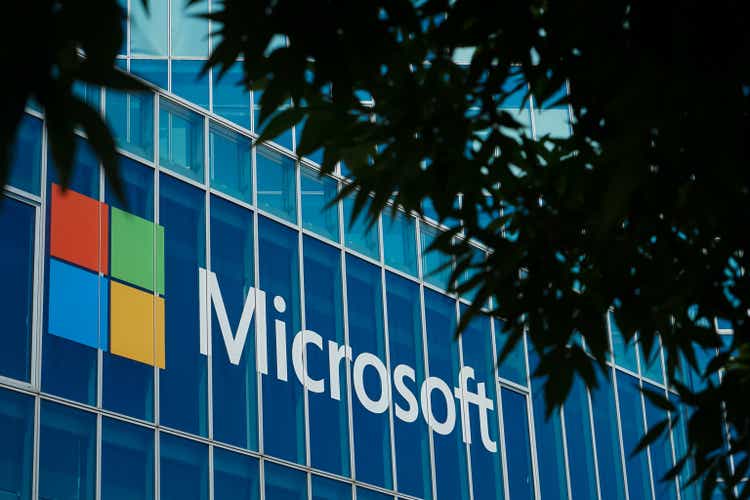lcva2
In January of this year I last had a look at Microsoft (NASDAQ:MSFT) after it has added some $70 billion in Activision Blizzard exposure, albeit that closing of the deal is far from a given, with regulatory hurdles needed to be overcome in various jurisdictions.
Microsoft has become a lot more active on dealmaking in recent years, with mixed results, as the move into gaming made quite some sense on paper given that gaming has become a more important contributor of the franchise.
The Base Case
Following a solid pandemic year in 2020, Microsoft grew 2021 sales by another 18% to $168 billion, with these results being released in the summer of that year. The company is incredibly profitable with operating profits reported around $70 billion on which adjusted earnings of $60 billion were posted. This came in close to $8 per share, as the company ended the year with a meaningfully higher run rate.
After a strong first quarter of the fiscal 2022 results it was obvious that the business was firmly on track to generate some $200 billion in sales in 2022, with earnings running closer to $9 per share and a $77 billion net cash position being equal to just over $10 per share with 7.5 billion shares outstanding.
Trading at $305 at the start of this year, down from a high already, valuations have become lofty at 12 times sales and around 33 times earnings, as the valuation of the firm reached a staggering $2.3 trillion. Given this huge valuation, a $69 billion deal for Activision was just a bolt-on deal for a firm the size of Microsoft, equal to just 3% of the own valuation, which thereby acquired titles like Call of Duty, World of Warcraft, and a few others.
The sales contribution of more than $8 billion indicates a more roughly 5% increase in total revenues, as the company is quite profitable as well, with the acquired acquisition multiple coming in below the valuation at which Microsoft traded at the time.
The idea was greater integration of the gaming platform and exposure to the Metaverse. With earnings running closer to $10 per share, I held a neutral stance at an 30 times earnings multiple as the duration risk of interest rates left investors exposed to interest rate and valuation risks, despite a stellar operating performance in recent years under the helmet of Satya Nadella.
A Reversal
Since the start of the year, shares of the company have fallen to a fresh low of $241 now, amidst rising interest rates, a period of dollar strength, slower growth and uncertainty on the Activation deal.
A 20% pullback looks interesting as the company has seen a continuation of growth with not too many noteworthy news events taking place in the meantime. Late in January, the company posted a 20% increase in second quarter sales to $51.7 billion, with earnings metrics rising at similar percentages. The $20 billion deal for Nuance, announced a year ago, was finally completed in March of this year.
In April, third quarter sales growth slowed down to 18%, in part the result of a stronger dollar as earnings growth started to lag topline sales growth, in part the result of the dilutive dealmaking of Nuance. In July, the company posted the fourth quarter results with revenues up just 12% (amidst 4 points of currency headwinds). As it turned out, full year revenues did still come in at $198 billion on which adjusted earnings of $9.21 per share were reported, with GAAP earnings actually coming in slightly higher for a change. Net cash was posted at $55 billion with holdings down a bit following the Nuance deal, but of course still ahead of the Activision deal, as holdings are equivalent to just over $7 per share.
With the same shares now trading at $241, the unleveraged assets go for $234 per share (ahead of the Activision deal), or 25 times earnings. This multiple has come down a bit from 30 times at the start of the year, as the earnings yield rose from 3.3% to 4.0% amidst rising interest rates as the macro environment made that reported (earnings) growth has slowed down dramatically here as well.
What Now?
Even after shares are down some $100 from the highs of last year, or close to 30%, I do not automatically see appeal following this big move as valuations were very demanding from the get go, and Microsoft’s performance has been hampered by the macro environment as of late.
After all, a current 4% earnings yield hardly surpasses the current risk-free rate, let alone inflation, as the company is not immune to a recession and dollar strength and thus normalization of valuation multiples as well. Note that the company has long traded at non-demanding multiples in the 2000s, actually trading at a multiple which marks a discount to the wider mark at the time.
Hence, shares have only moved from neutral or overvalued territory to fair value here. While the decline improves appeal, the move lower is not yet appealing enough to get involved as I would like to see further declines to a 20 times multiple, or closer to $200 per share, before looking to initiate a position here.


Be the first to comment